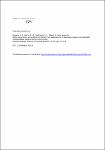Body mass index percentiles for children and adolescents in Germany based on a nationally representative sample (KiGGS 2003–2006)
Rosario, Angelika Schaffrath
Kurth, Bärbel-Maria
Stolzenberg, Heribert
Ellert, Ute
Neuhauser, Hannelore
Objective: To present body mass index (BMI) percentiles representative for children in Germany and to compare them with the currently used percentiles by Kromeyer–Hauschild (KH) and international percentiles of the World Health Organisation (WHO) and the International Obesity Task Force (IOTF). Methods:Representative examination survey of 17 641 children and adolescents aged 0–17 years living in Germany (KiGGS 2003–2006 study, response rate 67%) with standardized measurement of height and weight. Results: Generally, BMI in KiGGS was higher than in the reference populations from previous decades. KiGGS shows an asymmetric upward shift of the BMI distribution from about age 6 years and an earlier adiposity rebound compared with KH. The BMI peak in the first year of life is shown by KiGGS and WHO, but much less by KH. The cut-offs for overweight and obesity determined with the IOTF methodology in KiGGS (percentiles corresponding to BMI 25 and 30 kg/m2 at 18 years of age) were similar to IOTF cut-offs from age 18 to 10 years but systematically lower for younger children. Conclusions:The KiGGS BMI percentiles appear more valid for Germany than present alternatives and should be used for population monitoring. Despite their methodological limitations, the general shape of the older German KH references is confirmed by KiGGS for the ages 2–17 years. In order not to obscure the increase in obesity rates in the last decades, we therefore propose to continue using KH for individual diagnosis and estimation of the prevalence of overweight and obesity in this age range.
No license information

